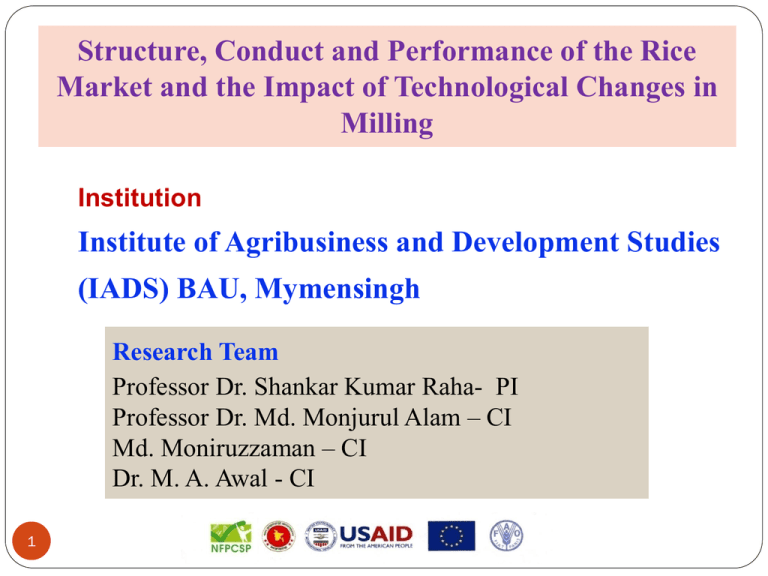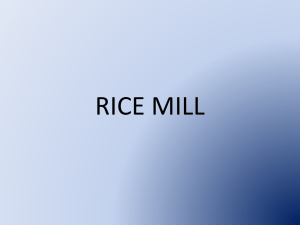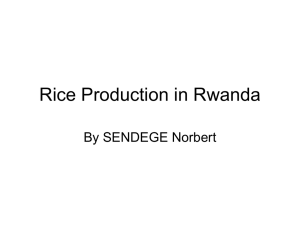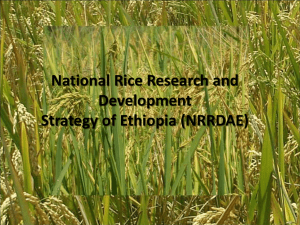
Structure, Conduct and Performance of the Rice
Market and the Impact of Technological Changes in
Milling
Institution
Institute of Agribusiness and Development Studies
(IADS) BAU, Mymensingh
Research Team
Professor Dr. Shankar Kumar Raha- PI
Professor Dr. Md. Monjurul Alam – CI
Md. Moniruzzaman – CI
Dr. M. A. Awal - CI
1
1 Background and Rationale of the Research Project
There has been concern over the efficient marketing
system of rice in Bangladesh
due to volatility of rice prices in domestic and international
market
Negative impacts on farmers and consumers
No visible sign of any serious
imperfection in rice
market.
Rapid technological changes in the rice milling.
Impact of semi-automatic and automatic rice mills
Increased volatility of international grain markets and the govt.
policy of rice exporting countries necessitate to assess the
integration of domestic and international markets.
2
Objectives of the Research Project
1. To provide evidence and provide new evidence on rice market
structure, conduct and performance in Bangladesh and
To analyze the impacts of technological changes in the rice
milling sector on employment, financial viability of rice
mills, market concentration, rice quality, and cost of milling
2. To construct detail estimates of costs and margins for key
agents along the rice marketing chain in Bangladesh and
to analyze market integration between domestic and
international markets.
3. To suggest policy implications for improving market structure,
conduct and performance.
3
Methodology
The study is conducted by adopting the structure,
conduct and performance approach (SCP). This
technique was first formalized by Mason (1939) and his
detailed case study approach was modified by Bain
(1951).
Market structure
4
Market conduct
Market performance
Methodology (Contd.)
Area
District
Faria
Bepari Aratdar
Miller Aratdar Aratdar
cum
wholesal
er
cum
wholesale
r
Paddy
wholesal
er
Wholesal
er cum
retailer
Retailer Importer
Milled rice
Key agents
Dinajpur
Surplus
Rangpur
Naogaon
Bogra
Sherpur
Comilla
Kushtia
Deficit
Sylhet
Khulna
Dhaka
Noakhali
Chittagong
Total
5
15
0
3
2
0
1
16
0
0
0
2
0
39
17
13
27
15
1
3
2
7
2
10
4
5
134
13
16
21
6
32
3
7
0
7
1
5
2
112
20
10
20
8
15
2
25
2
2
2
2
2
110
0
3
1
0
4
0
0
0
6
16
0
0
30
6
7
5
2
0
0
0
0
4
0
0
0
24
5
3
10
15
8
10
17
11
8
10
12
20
129
8
4
0
0
2
14
4
9
9
5
6
5
66
11
13
11
7
8
1
8
5
3
11
10
15
103
2
3
5
Methodology (Contd.)
(a) Estimation of market concentration
4 firm concentration ratio, Entropy index, and Gini coefficient
(b) Financial viability of the mills was assessed by using NPV, IRR, BCR.
(c) Calculation of marketing costs and margins was done by using
standard formula (Kohls and Uhl, 2005)
(d) Market integration
Market integration was examined by applying co-integration
method developed by Engle and Granger
Data: monthly wholesale price from 1990 to 2011(domestic mkts).
Data: monthly export price of rice from Thailand, Vietnam, and
Eastern India converted into import parity price (2000 to 2011)
6
Overview of the structure, conduct and performance of rice
market in Bangladesh
Researcher Year
Findings
Farruk,
1970 He labeled the markets as oligopolistic as well as
M.O.
oligopsonistic but close observation of the functioning of
this structure in the different markets did not support the
prevalence of unethical market conduct.
Islam et al 1987 The net return to all the functionaries in the channels was
low due to intense competition. Excessive profit of the
functionaries was not found. Capacity utilization of the mills
varied from 40% to 65% at the peak period and 20% to 48%
in low volume months.
Chowdhury 1992 The market was found atomistic on both sides. The
, N.
aratdar-cum wholesalers were powerful in the rice market
as they handled about 80% -90% of all rice. No excessive
concentration was found in rice milling industry.
7
Overview of the structure, conduct and performance of rice
market in Bangladesh contd.
Rahman, 1998 No collusion among the sellers and buyers were
S.M.S.
observed but the millers complained about aratdars’
collusive activity.
Siddique 2010 He found low level of concentration in the rice milling,
The millers are price taker not price maker.
, M.A.B.
Performance of the rice milling industry was not
good in terms of capacity utilization.
Maximum mills are running with decades old
machines.
8
Overview of the structure, conduct and performance of rice
market in Bangladesh contd.
Reardon 2012
et.al.
9
The sampled small and automatic mills were
started in 1998 while medium/semi-automatic rice
mills were started in 2000. The mills doubled in
capacity by 2009.
Rice milling was becoming more concentrated in
medium and large mills and technology was
changing.
The uses of mills were highly seasonal.
The millers and wholesalers were selling branded
and labeled bags to traders.
Structure, conduct and performance of paddy market in Bangladesh
Table1: Buyer concentration in paddy markets
Name of the Market
Market day
Birganj, Dinajpur
Sunday, Wednesday
40 -50
85
Abadpukur, Naogaon
Sunday, Wednesday
90-100
85
Naimile Bazar, Bogra
Sunday, Wednesday
15 -20
80
Kalampur, Dhaka
Thursday
70-75
80
Ambari, Dinajpur
Friday, Monday
35- 50
75
Nalita Bari, Sherpur
Saturday, Tuesday
70- 75
75
Chandina, Comilla
Tuesday, Friday
20-25
66
Shatibari Bazar, Rangpur
Saturday, Wednesday
40 -50
60
Dhantara, Dhaka
Monday
50-60
60
10
Average Concentration
number of Four –Firm
of buyers
(%)
Structure, conduct and performance of paddy market in Bangladesh
Table 1: Buyer concentration in paddy markets contd.
11
Fultala,Khulna
Trimohini, Naogaon
Sharua-Bottala Bazar ,Bogra
Farmhat, Dinajpur
Choudhurani, Rangpur
Ailchara Bazar, Kushtia
Haris Choudhury Bazar, Noakhali
Dhara Bazar, Mymensingh
Mirsharai, Chittagong
Kalirghat, Kazir Bazar, Sylhet
Sunday, Wednesday
Saturday, Tuesday
Sunday, Wednesday
Saturday, Tuesday
Sunday, Thursday
Wednesday
Monday, Friday
Monday, Friday
Monday, Tuesday
No fixed day
45 -50
40- 50
40-50
70-80
60- 70
100-150
50-60
70 -80
30-40
25-30
58
57
55
51
50
45
38
36
35
32
Halsa, Kushtia
Saturday , Tuesday
40- 50
30
12
Trimohini, Naogaon
Fultala,Khulna
Halsa, Kushtia
Kalirghat, Kazir Bazar, Sylhet
Mirsharai, Chittagong
Dhara Bazar, Mymensingh
Haris Choudhury Bazar, Noakhali
Ailchara Bazar, Kushtia
Choudhurani, Rangpur
Farmhat, Dinajpur
Sharua-Bottala Bazar ,Bogra
Markets
Dhantara, Dhaka
Shatibari Bazar, Rangpur
Chandina, Comilla
Nalita Bari, Sherpur
Ambari, Dinajpur
Kalampur, Dhaka
Naimile Bazar, Bogra
90
Abadpukur, Naogaon
Birganj, Dinajpur
4 firm concentration (%)
Structure, conduct and performance of paddy market in Bangladesh
Figure 1. Buyer concentration in paddy markets
80
70
60
50
40
30
20
10
0
Structure, conduct and performance of paddy market in Bangladesh
2. Entry barrier
Table 2 : Problems for the new entrant as perceived by established traders
Sl.
No.
Problems
Faria
Bepari
1
2
Suitable site for shop
Shortage of rice supply
Index
0.709
0.628
3
4
5
6
7
Insufficient capital
Government permission
Price fluctuation
Competition among traders
Bribery/ unofficial payment/
0.932
0.189
0.432
0.588
0.382
I
VIII
VI
V
VII
0.906
0.188
0.372
0.670
0.378
I
VIII
VII
IV
VI
8
threats
Business risk
0.699
III
0.682
III
13
Rank
II
IV
Index
0.752
0.589
Rank
II
V
Aratdar-cumwholesaler
Index Rank
0.779
II
0.552
V
0.913
I
0.177 VIII
0.375
VII
0.641
IV
0.384
VI
0.684
III
Structure, conduct and performance of paddy market in Bangladesh
3. Degree of product differentiation (paddy)
No deliberate effort is made to make the paddy
differentiated in the market.
4. Distribution of market information
No formal system exist for dissemination of market
information.
Paddy traders collect market information through
their own effort.
14
Structure, conduct and performance of paddy market in Bangladesh
5. Conduct at paddy market
Table 3: Price setting mechanisms during buying and selling paddy
Process/
Mechanism
Bargaining
between seller and
buyer
Set by seller
Faria
37
Buying price
Bepari Aratdar- cum- Faria
wholesaler
136
(100.00) (97.14)
0
4
(2.86)
0
0
Set by buyer
Predetermined
15
Selling price
Bepari
Aratdar- cumwholesaler
111
27
100
79
(96.52)
(60.00)
(62.11)
(59.39)
3
(2.61
0
8
(17.78)
5
(11.11)
30
(18.63)
14
(8.70)
36
(27.07)
9
(6.77
1
(0.87)
5
(11.11)
17
(10.56)
9
(6.77)
Structure, conduct and performance of paddy market in Bangladesh
6. Performance of paddy market
Paddy market is operating smoothly throughout the
country;
Millers are getting paddy as much they need, though
farmers are not getting reasonable price for their paddy.
From farmers’ perspective, paddy market is not running
in favour of them.
16
Market structure, conduct and performance of rice
milling industry
1.1 Dimensions of market structure (4)
Table 4. Seller concentration in rice mill industry
Measure
CR4
CR20
Entropy Index , (E)
Gini –Coefficient
Seller concentration in rice mills
0.69 %
2.16 %
3.60 ,Log n =3.66
0.243
1.2 Degree of product differentiation
Product differentiation is exist buy does not create any
significant for competition
17
Market structure, conduct and performance of rice milling industry contd.
Table 5. Major problems for potential entrant as perceived by
established mills
SL
Problems
Automatic mill
No.
Index
Rank
Semi-auto mill
Index
Rank
Husking mill
Index
Rank
1
Suitable site for mill
0.437
V
0.636
I
0.614
I
2
Shortage of paddy supply
0.000
-
0.045
VIII
0.105
VII
3
Shortage of supply of skilled
manpower
0.637
II
0.627
II
0.548
III
4
Non availability of huge capital
0.487
IV
0.427
V
0.474
V
5
Obtaining Govt. permission
0.062
VII
0.172
VII
0.094
VIII
6
Lack of utilities (power supply,
gas and water)
0.675
I
0.572
III
0.502
IV
7
Tough
from
0.525
III
0.472
IV
0.557
II
Non - availability of processing
0.150
VI
0.254
VI
0.191
VI
competition
established mill
8
plant
18
Market structure, conduct and performance of rice milling industry contd.
Table 6. Reasons for exit from the market
Reasons
Automati Semi- Automatic Husking mills
c mills
mills
Incurred a loss
14 (87.5)
Shift the location
0
Shift to other business
2(12.5)
Conflict among the partners
0
Left for abroad
4(25.0)
Could not survive in the
8 (50.0)
face of competition
19
Frequency of responses
22(91.67)
55(78.57)
2(8.33)
4(5.71)
11(45.83)
16(22.86)
2(8.33)
1 (1.43)
3(12.50)
0
19(79.17)
49 (17.00)
Market structure, conduct and performance of rice milling industry contd.
2. Market conduct
2.1 Price Policies
Selling price of rice is set independently
Automatic rice mill owners are in better position in negotiation for
setting price.
In the case of husking and semi-automatic mills buyers are more
powerful.
2.2 Product Policy
With the changing of milling technology, millers are capable to process rice
according their own choice and also to buyer’s choice
Sometimes the millers supply rice with labeling as per direction of traderbuyers.
20
2.3 Policies aimed at coercing rivals
No evidence of predatory and/or exclusionary tactics adopted
by the established firms in rice market.
3. Performance-Dimensions
Capacity utilization (%)
Figure 2. Capacity utilization of rice mills
57
56
55
54
53
52
51
50
49
56.24
54.45
51.78
Automatic
Semi-automatic
Rice mill
Size of selling cost
Product quality
Progressiveness of the industry
Employment position
Discrimination by sex
21
Husking
Impact of technological changes in rice milling
Number of husking rice mills are shrinking and the
businesses are shifted either to semi-automatic or to
automatic rice mills.
The demand for quality rice (brightness, polishing, free
from foreign particulars and black rice) and higher price
encouraged semi-automatic and automatic rice mill
owners to use the new technologies.
The bran of semi-automatic and automatic rice mills
have good demand in the edible oil mills
Automatic rice mills have overcome the problem of
rainy season and shortage of labour supply for
processing of paddy.
22
Impact of technological changes in rice milling contd.
Table 7: Milling cost and profit by different types of rice mill
Type of rice
mill
Husking
SemiAuto*
SemiAuto**
Auto rice
mill*
Auto rice
mill**
23
Cost of
paddy
(Tk.)
Milling
cost
(Tk./ton
of rice)
24300
2601
25427
Byproduct
Total
return
(Tk.)
Profit
(Tk.)
Whole
rice
recovery
%
26901 27000
2230
29230
2329
65.00
2943
28370
28500
2414
30914
2544
66.25
26016
3452
29468
30000
3448
33448
3980
64.75
25177
2563
27740
30000
3478
33478
5738
67.5
26361
3070
29431
32000
3712
35712
6281
66.00
*Without modern equipment
**With modern equipment
Total
cost
(Tk.)
Return (Tk.)
Rice
Table 8. Employment in different rice mills
Type of rice
mill
Husking
Semi-Auto*
SemiAuto**
Auto rice
mill*
Auto rice
mill**
Labour,
Tk/ton of
paddy
Staff cost,
Tk/ton of
paddy
403
403
483
147
168
216
14.17
14.17
15.67
100
173
116
101
*Without modern equipment
**With modern equipment
24
Employment
Labour,
Labour,
man-hr/
manton of
days/yr
paddy
Staff,
manhr/ton of
paddy
Staff,
mandays/yr
2232
2274
3015
6.95
9.13
4.50
1095
1095
1460
3.20
3120
5.99
5840
3.95
5925
4.14
6205
Financial viability of the rice mills
Type of mill
IRR
Husking rice
18.45%
mill
Semi-auto rice 25.23%
mill
Auto-rice mill
25
32.54%
NPV(‘000Tk.)
at 10%
BCR
(at 10%)
418
1.002
10325
1.046
117471
1.063
Farmer
Faria
Aratdar-cum-wholesaler
Bepari
Procurement
centre
Rice miller
Aratdar
Aratdar-cum-wholesaler
Paddy processor
Wholesaler
Wholesaler-cum-retailer
Retailer
Government
procurement
Consumer
Figure 3: Typical Marketing Channels of Paddy/ Rice in Bangladesh
26
Table 10. Marketing margins of paddy/rice for different actors
(for 1 quintal of rice /and equivalent amount of paddy)
Actors
Faria
Bepari
Aratdar-cumwholesaler
Gross
margin
Amount
114.91
111.00
93.67
Rice mill
Aratdar(Rice)
Wholesaler
Wholesaler cum
retailer
Retailer
Total
27
*only from rice
marketing Marketing cost
%
6.14
5.93
5.01
Amount
66.17
70.50
56.17
%
6.94
7.4
5.89
849.98
(524.10)*
27.81
216.02
261.53
45.40
45.20
1.49
11.50
14.00
430.38
(417.46)*
7.81
145.16
144.91
196.51
1871.43
10.50
100
31.90
953
** Commission
Net
marketing
margin
Amount
%
48.74
5.30
40.50
4.41
37.50
4.08
0.82
15.19
15.21
419.60
(106.64)*
20.00**
70.86
116.62
45.70
2.18
7.71
12.70
3.35
100
164.62
918.43
17.92
100
Figure 4: Marketing margins of paddy/rice for different actors
(for 1 quintal of rice /and equivalent amount of paddy)
2000
1800
1600
196.51
Retailer
261.53
Wholesaler cum
retailer
216.02
Wholesaler
1400
1200
27.81
Aratdar(Rice)
1000
800
849.98
600
145.16
7.81
400
430.38
200
0
28
31.9
144.91
93.67
111
114.91
56.17
70.5
66.17
Gross marketing margin
Marketing cost
164.61
Rice mill
116.62
70.86
20
Aratdar
419.6
Bepari
37.5
40.5
48.74
Net margin
Faria
Share of different actors in gross marketing margin, marketing cost and net margin
100%
90%
80%
70%
60%
10.5
3.35
15.2
17.92
14
11.5
1.49
15.2
12.7
0.82
7.71
2.18
Retailer
Wholesaler cum
retailer
Wholesaler
Aratdar(Rice)
50%
40%
45.4
Rice mill
45.2
45.7
30%
20%
10%
0%
5.01
5.93
6.14
Gross marketing margin
29
Bepari
5.89
6.94
4.08
4.41
5.3
Marketing cost
Net margin
7.4
Aratdar
Faria
in 2010
30
Map 6.1: Extent of rice surplus and deficit at district level in 2010
Integration of Rice market
ADF test shows that all the rice price series were non-stationary
31
at level but stationary in their first differences.
All the 12 districts rice markets found integrated
Dhaka market is significantly integrated to all regional markets of
rice markets in Bangladesh due to having the facility of
infrastructure and information technology, which closely
connected the markets to each other.
Price move in the unison in all the markets together. Central
price policy making will be effective in rice market.
Rice market of Bangladesh , Eastern India, Vietnam and Thailand
found integrated also
Suggested policy options
Paddy market
Structure –Oligopsonistic and atomistic
Formation of farmers’ marketing cooperative / group
Development of market yard for paddy market as most of the paddy
32
markets sit along and /on the road
Provision of credit facilities to paddy traders. The traders should have
trading licenses.
Conduct
Cost of inputs in paddy production can be reduced through adopting
cost reducing technologies and optimum utilization of machines.
Arrangement to be made to disseminate paddy prices of different
important markets through mobile phones.
Display of buying prices of paddy on board by buyers Association /
market committee on market.
Suggested policy options contd.
Rice mills
Structure
Husking mills should be modernized to semi-automatic/automatic
rice mills. Profitable cases should be financed
Conduct
Development and introduction of quality standard for rice in the
market
The rice bag should contain minimum information about the product
(name of the mill, its location, date of processing, number of boiling,
net weight, variety of rice, millgate price). Labeling on the bag of rice
should be mandatory
Needs investigation of the nutritional aspects of milled rice after extracting
bran to ensure the quality of rice
33
Suggested policy options contd.
Performance
Ensure regular and undisrupted power supply to rice mills
Make available of spare parts at reasonable prices in markets
Quality standard of the spare parts may be introduced
Contractual arrangements btw. rice growers and millers
Improvement in processing technology should be encouraged
through providing various services (credit facility, technical
knowledge and necessary permission)
Installation of Engleberg rice huller in the country should be
banned
Vocational training programme helps to produce qualified
personnel for operating automatic rice mills
34
Suggested policy options contd.
Ensure optimum use of by-products such as husk, bran,
broken rice, husk–ash.
Wage discrimination by sex needs to be addressed.
Arrangement of foreign visits particularly the rice exporting
countries for the millers may help to change the attitudes to
the business. FAO may sponsor such visits.
Govt. should develop a complete and accurate data base on
rice mills and market intermediaries.
35
36







